August 4, 2024 — They say a penny doesn't go far these days, to which NASA has now added its two cents.
Two pennies lifted off for the International Space Station (ISS) on Sunday (Aug. 4), on a mission that will ultimately log millions of miles. The U.S. one-cent coins were launched on the "S.S. Francis R. 'Dick' Scobee," Northrop Grumman's 21st Cygnus cargo spacecraft, named in memory of the fallen commander of NASA's space shuttle Challenger.
Sent skyward by a SpaceX Falcon 9 rocket from the Cape Canaveral Space Force Station in Florida, the two pennies were a rare addition to the uncrewed capsule's 8,200 pounds (3,720 kilograms) of cargo.
"The pennies are going to be used in what's called the 'Screaming Balloon' demonstration," said Michele Hooks, education project manager for NASA's Office of STEM Engagement, in an interview with collectSPACE. "A penny will get inserted in a deflated balloon and then an astronaut will inflate the balloon and give it a whirl in order to compare it to a hex nut spun inside a second balloon."
The "STEMonstration" is the latest in a series of short educational videos filmed on the space station that are aimed at engaging grade school children in science, technology, engineering and mathematics (STEM) topics. Every STEMonstration is designed so that the students can reproduce the experiment in their classroom — hence the use of pennies.
"We wanted a simple thing that students could get access to and pennies are in abundance," said Hooks.
Search for cents
Pennies are, indeed, easy to find, assuming you are happy with any random cent. For the coins now in space, Hooks and her team were a bit more selective.
"We wanted pennies minted in 2024 to commemorate the year they were sent into space and the year the astronauts were on the station. We also wanted them to be shiny pennies because they are going to be on camera," Hooks said.
Checking her own spare change, Hooks did not have a 2024 penny. She then went to her local bank and despite going through hundreds of pennies, could not find a cent that was minted this year.
"The bank teller was giving me some strange looks until I explained, 'These are actually going to the space station and I need to have them cleared tomorrow,'" Hooks said. "So then the teller started opening up different rolls of pennies and others started helping me. I don't know how many rolls we went through, but we could not find a single 2024 penny."
Some of the tellers questioned if the U.S. Mint had struck pennies for this year. In fact, more than 800 million Lincoln cents were minted and had entered circulation by April. So Hooks put the call out at NASA and to her network of educators. "Who has a 2024 penny?"
"I ended up getting a couple from folks who work at Johnson Space Center and then some from local teachers. I put them together, picked the shiniest ones and those are the two that went up," she said.
Penny population
The two pennies now in space are not the first to leave Earth, but are still a rare "change" to what is typically launched.
"From my research, I am aware of a U.S. penny flown on Apollo 11 (by Neil Armstrong, no less) [and] a couple of pennies flew on Apollo 14 — one as part of a multi-coin set, and a 1948-D penny," said Richard Jurek, co-host of the "Two Space Collectors Collecting Space" podcast and founder of The Jefferson Space Museum, a website devoted to the history of the $2 bills that have orbited Earth or went to the moon.
"On Apollo 15, a 1969-D penny and a 1970-D penny flew for members of the support crew. Also flown on this mission for support crew members was an 1845 Large Cent, and an Indian Head penny (date not known)," said Jurek. (The "D" is for Denver, one of the locations where the U.S. Mint strikes coins, in addition to Philadelphia ["P"] and San Francisco ["S"].)
The first penny flown into space might also be the oldest and most valuable. A 1793 Flowing Hair cent — only the second style of penny issued by the U.S. — was flown for a coin collector by way of the Gemini 7 crew's flight surgeon in 1965. The already rare one-cent piece, which was packed inside the mission's inflight medical kit (without NASA's prior knowledge), was sold at auction 50 years later for $82,250.
In 1972, following a congressional investigation into the personal items carried by astronauts, NASA set a policy that crew members could not fly certain items, including coins, which "by their nature, lend themselves to exploitation by the recipients." The directive still stands today, so no astronaut on a U.S. mission has packed pennies in more than 50 years.
The same restriction applies to the Official Flight Kit (OFK), a duffel bag-sized pouch of mementos that are flown by NASA and its partners, as well as the crew, for distribution to organizations and employees.
But the policy does not apply to robotic explorers on one-way trips into space.
The farthest flown penny landed on Mars in 2012. The "red cent," called such because it soon became covered in Mars dust, was mounted to the calibration target for the Mars Hand Lens Imager (MAHLI) on NASA's Curiosity rover.
Principal investigator Ken Edgett picked out and purchased the penny, a 1909 "VDB" cent, that includes the initials of the coin's designer (Victor David Brenner) and was minted on the centennial of President Abraham Lincoln's birth. Edgett attached it to the target as a "tip of the hat" to the informal practice by geologists of placing a coin (or other object of known scale) in their field photographs.
Cents for circulation
Hooks said that she was unaware of any other pennies launched by the education office. As to the current pair, they may "enter circulation" aboard the space station.
"With our educational items, in particular, we look at using them many times as we possibly can in novel ways," she said. "So I imagine you will see these pennies be repurposed as many times as we possibly can before they return back to Earth." |
|
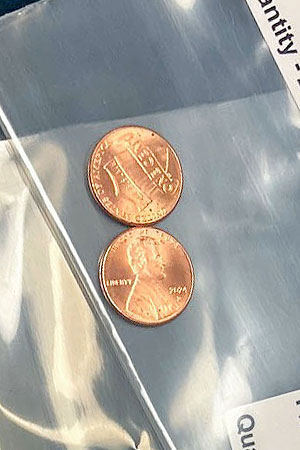
Two U.S. pennies, seen as they were packaged for flight, are now the latest cents to fly into space on NASA missions. (NASA)
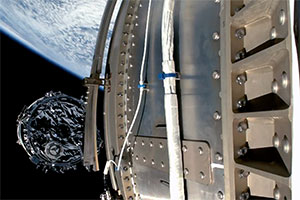
Northrop Grumman's "S.S. Francis R. 'Dick' Scobee" Cygnus cargo spacecraft separates from the second stage of a SpaceX Falcon 9 rocket beginning its trip to the ISS, Sunday, Aug. 4, 2024. (SpaceX)
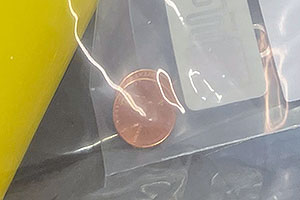
Michele Hooks of NASA's Office for STEM Engagement found two shiny 2024 pennies, seen here packed for launch, to fly as part of a student STEMonstration to be filmed on the ISS. (NASA)
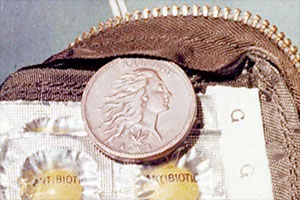
NASA photo of a 1793 "Flowing Hair" cent that flew on the Gemini 7 mission in the crew medical kit in 1965. (NASA/Stack's Bowers)
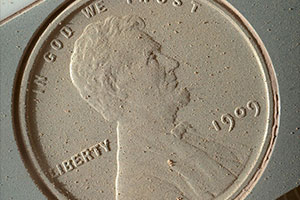
A 1909 "VDB" penny covered in dust is photographed after more than a year on the calibration target for the Mars Hand Lens Imager on NASA's Curiosity rover (NASA/JPL-Caltech/MSSS), |
